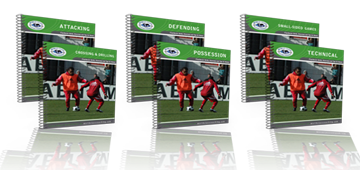By Lawrence Fine, Author of the FineSoccer Coaching Bible.
Welcome to the FineSoccer Drills Newsletter. Todays topic is a bit different in that it looks at the purpose of drills instead of at a particular drill.
At some of the coaching courses they teach you to NOT use the word “drill”. Instead, we should use “game”, “exercise” or “activity”. Part of the reason seems to be that “drill” seems to have a connotation related toward the military and instead, we want things to seem “fun” and games/exercises/activities sound more “fun” than drills.
Others look at “drills” as things done in a line (with a lot of standing around before and afterwards) while games are free flowing competitions which are enjoyable
Personally, I have always thought that whether we call them drills, games, exercises or activities is just a matter of semantics. It really comes down to whether it’s something the players can learn from and then apply in their real games.
As an example, while it might be fun for a team to scrimmage all training session, every training session, it’s probably not the most efficient use of time. Some might think this is a good way to recreate the “street soccer” environment that many of the past superstars grew up with but it’s more than just playing. When we hear about the Brazilians (feel free to replace the nationality) learning to play by playing pick up soccer all day, some feel simple scrimmages is the way to replicate that. The thing is, in most cases, they have grown up with younger, less experienced players playing with older more experienced players and the younger players can learn from the older players. In our case, having all of the players similar in age and ability loses that learning opportunity. If you have 16 equal players playing against each other, they have no one to learn from (other than trial and error). If you have 16 players of different levels, the lesser players can and will learn from the better players. A lesser player can pick up a move, an idea or a trick by seeing someone else do it (whether it was done to them or to someone else). If no one has that move, idea or trick, it’s much more difficult to learn.
By teaching these ideas in a “drill” (or whatever you want to call it) and then having the players try them with no opposition, then with limited opposition, then at full speed and then in a game situation, it’s more likely the players will be able to learn and then carry these concepts over to a game situation.
If you do want to call the “more boring” parts of training drills, then start with drills to introduce the concept, then gradually build up to games/exercises and activities.
[wpsharely id="1204"][/wpsharely]Rather than worrying about terminology, I would prefer people to develop their training in the following way:
- Warm up
- Introduce the concept
- Demonstrate the concept
- Try the concept with no pressure
- Try the concept with limited pressure
- Try the concept with full pressure
- Apply the concept in a limited directional activity
- Create a game encouraging the concept
- Remove any restrictions to see if the concept “stuck”
- Apply the concept in a game
The first few steps can be done quickly (depending upon the level of the group) but skipping over the steps all together will make the learning opportunity much more difficult
Have a great day!
Lawrence
By Lawrence Fine, Author of the FineSoccer Coaching Bible.



